Toolbars and Status Bars
Toolbars and Status Bars
Fundamentals of Toolbars
Introduction
A toolbar is a bar that displays in the top section under the main menu. Here is an example:

A toolbar is a classic control container. It can host text, buttons, etc. It is up to you to decide whether your application needs a toolbar and what you want to position on it.
![]() Practical Learning: Introducing Tool Bars
Practical Learning: Introducing Tool Bars
Creating a Toolbar
You can create a toolbar visually or programmatically. To support toolbars, the .NET Framework provides a class named ToolStrip. The ToolStrip class is derived from the ScrollableControl class and implements both the IComponent and the IDisposable interfaces.
The previous versions of the .NET Framework included a class named Toolbar used to create a toolbar. That class is still available and you can use it if you want. The ToolStrip class is preferred because it provides some additional functionality. In all our lessons, unless specified otherwise, whenever we need a toolbar, or if we refer to a toolbar, it always means the ToolStrip class or the ToolStrip object from the Toolbox. |
Therefore, to start a toolbar, declare a variable of this class. Because a toolbar is hosted by a container, namely a form, if you want to display it, you should (must) add it to the Controls collection of its host. Here is an example:
using System.Drawing;
using System.Windows.Forms;
public class Exercise : System.Windows.Forms.Form
{
ToolStrip toolbar;
public Exercise()
{
InitializeComponent();
}
void InitializeComponent()
{
toolbar = new ToolStrip();
Controls.Add(toolbar);
}
[STAThread]
static int Main()
{
System.Windows.Forms.Application.Run(new Exercise());
return 0;
}
}
This would produce:

To help you visually create a toolbar, in its Container section, the Toolbox provides a ToolStrip button that you can click and click your form.
Whether using code or visual design, you can create as many toolbars as you see fit.
Characteristics of a Toolbar
Introduction
A toolbar is primarily a container, which itself means nothing and doesn't even do anything. The controls you position on it give it meaning. Still, because of its position, it enjoys some visual characteristics but also imposes some restrictions to its objects. Although it is a container, a toolbar must be hosted by another container. For this reason, the dimensions, namely the width, of a toolbar are restricted to those of its host. When you add a toolbar to a form, it automatically positions itself in the top section of the form and uses the same width as the form. This means that the default Dock value of a toolbar is Top.
Introduction to the Items of a Toolbar
By default, just after you have added a toolbar to your form, it is empty, waiting for you to add objects to it. To hold its collection of objects, the ToolStrip class is equipped with a property named Items. The ToolStrip.Items property is an object of type ToolStripItemCollection. Each member of the ToolStripItemCollection class is of type ToolStripItem.
During desgin, to add the desired items, do one of the following things:
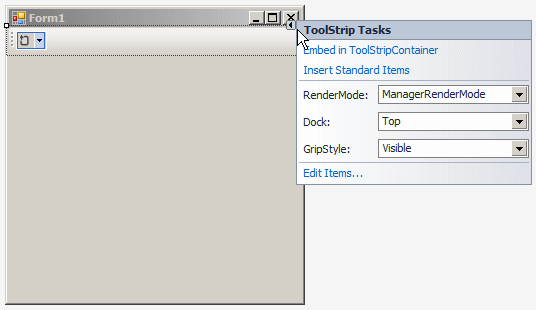
Any of these actions would open the Items Collection Editor where you can individually select items, click Add, and configure them:
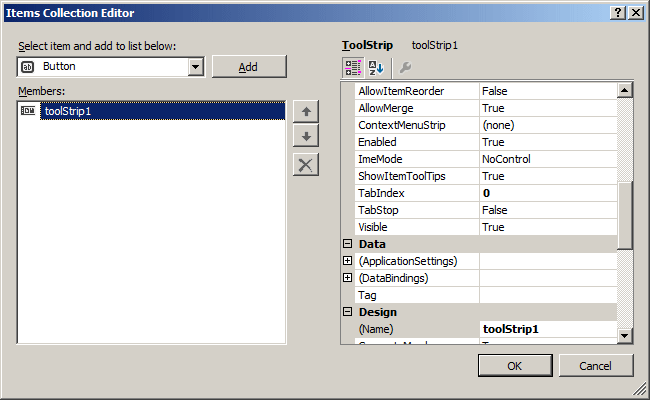
Instead of adding objects one by one, Microsoft Visual Studio provides a default or standard design for a toolbar. To use it, after visually adding the toolbar to a form:
Any of these actions would equip the toolbar with the most common buttons used on a standard toolbar.
The Buttons of a Toolbar
The most common object of a toolbar is a button. If you are working visually, to add a button to a toolbar, click the toolbar. An icon would display. Click that button:
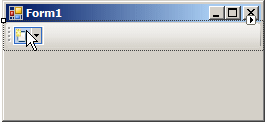
A button of a toolbar is based on a class named ToolStripButton. The ToolStripButton clas is derived from the ToolStripItem class which, as mentioned before, is represented by the Items property that is a member of the ToolStrip class.
To programmatically create a toolbar button, declare a variable of this class. The ToolStripButton class is equipped with 6 constructors. You can use the default constructor if you are not ready to provide the other pieces of information a button may need. After declaring the variable, add it to the Items property of its container. Here is an example:
using System.Drawing;
using System.Windows.Forms;
public class Exercise : System.Windows.Forms.Form
{
ToolStrip toolbar;
ToolStripButton btnCreate;
public Exercise()
{
InitializeComponent();
}
void InitializeComponent()
{
toolbar = new ToolStrip();
btnCreate = new ToolStripButton();
toolbar.Items.Add(btnCreate);
Controls.Add(toolbar);
}
[STAThread]
static int Main()
{
System.Windows.Forms.Application.Run(new Exercise());
return 0;
}
}
By default, a button of a toolbar displays an icon on top. If you click the toolstrip to create a button, the new button receives a default icon:
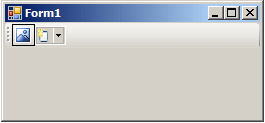
To specify or change the icon of a button, after clicking it, in the Properties window, click Image, then click its browse button. In the Select Resource dialog box, click Import, locate the desired icon, select it, and click OK. To programmatically specify the icon of a button, you have many options. The ToolStripButton class is equipped with a property named Image. Assign an icon to this property. Here is an example:
void InitializeComponent()
{
toolbar = new ToolStrip();
btnCreate = new ToolStripButton();
btnCreate.Image = Image.FromFile(@"C:\Icons Collection\create.ico");
toolbar.Items.Add(btnCreate);
Controls.Add(toolbar);
}
The ToolStripButton class provides another constructor whose syntax is:
public ToolStripButton(Image image);
When creating a button, you can use this constructor to directly specify its icon. Here is an example:
void InitializeComponent()
{
toolbar = new ToolStrip();
btnCreate = new ToolStripButton(Image.FromFile(@"C:\Icons Collection\create.ico"));
toolbar.Items.Add(btnCreate);
Controls.Add(toolbar);
}
If an icon is not explicit enough, you can make it display text or a combination of an icon and text. To support this, the ToolStripItem class provides a property named DisplayStyle. This property is of type ToolStripItemDisplayStyle, which is an enumeration. The members of the ToolStripItemDisplayStyle are:
To visually configure this behavior, access the Properties window for the button and, in the DisplayStyle field, select the desired member. To do this programmatically, access the DisplayStyle property and assign the desired value to it.
If you want a button to display text, first select either Text or ImageAndText for the DisplayStyle property. To visually specify the text to display, type it in the Text property. To do it programmatically, you have various options. You can assign a string to the Text property of the button. Here is an example:
using System.Drawing;
using System.Windows.Forms;
public class Exercise : System.Windows.Forms.Form
{
ToolStrip toolbar;
ToolStripButton btnCreate;
public Exercise()
{
InitializeComponent();
}
void InitializeComponent()
{
toolbar = new ToolStrip();
btnCreate = new ToolStripButton();
btnCreate.DisplayStyle = ToolStripItemDisplayStyle.Text;
btnCreate.Text = "Create";
toolbar.Items.Add(btnCreate);
Controls.Add(toolbar);
}
[STAThread]
static int Main()
{
System.Windows.Forms.Application.Run(new Exercise());
return 0;
}
}
This would produce:
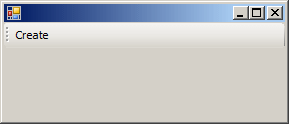
The ToolStripButton class is equipped with another constructor whose syntax is:
public ToolStripButton(string text);
You can use this constructor to create a toolbar and specify its text. Of course, you must specify an appropriate value for the DisplayStyle property. Here is an example:
void InitializeComponent()
{
toolbar = new ToolStrip();
btnCreate = new ToolStripButton("Create");
btnCreate.DisplayStyle = ToolStripItemDisplayStyle.Text;
toolbar.Items.Add(btnCreate);
Controls.Add(toolbar);
}
To display both an icon and text, select the appropriate value of the DisplayStyle property. Then, in the Properties window of the button, specify the icon and enter the desired text. Otherwise, the ToolStripButton class provides another constructor whose syntax is:
public ToolStripButton(string text, Image image);
If you decide to use this version, pass the appropriate arguments.
To use a button, the user can click it. Therefore, you should create an event handler for the button. You can use the Events section of the Properties window or programmatically write it. Here is an example:
using System.Drawing;
using System.Windows.Forms;
public class Exercise : System.Windows.Forms.Form
{
ToolStrip toolbar;
ToolStripButton btnCreate;
public Exercise()
{
InitializeComponent();
}
void InitializeComponent()
{
toolbar = new ToolStrip();
btnCreate = new ToolStripButton("Create");
btnCreate.DisplayStyle = ToolStripItemDisplayStyle.Text;
btnCreate.Click += new EventHandler(btnCreateClick);
toolbar.Items.Add(btnCreate);
Controls.Add(toolbar);
}
private void btnCreateClick(object sender, EventArgs e)
{
MessageBox.Show("The document will be created");
}
[STAThread]
static int Main()
{
System.Windows.Forms.Application.Run(new Exercise());
return 0;
}
}
Otherwise, the ToolStripButton class supports all the normal events of a button.
Menu Items on a Toolbar
Instead of a classic button, you can create a type of menu on a toolbar so that, when the user clicks the button, a menu would come up. To get it:
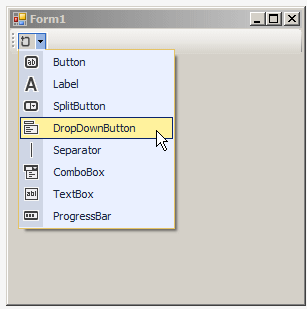
The button that is equipped with a menu is available through a class named ToolStripDropDownButton. This class inherits from a class named ToolStripDropDownItem.
The ToolStripDropDownButton class has seven constructors. To programmatically create a drop down button, you can declare a variable of type ToolStripDropDownButton using its default constructor, allocate memory for it using the new operator, and add it to the Items collection of the ToolStrip variable. Here is an example:
using System.Drawing;
using System.Windows.Forms;
public class Exercise : System.Windows.Forms.Form
{
ToolStrip toolbar;
ToolStripDropDownButton ddRecentlyUsed;
public Exercise()
{
InitializeComponent();
}
void InitializeComponent()
{
toolbar = new ToolStrip();
ddRecentlyUsed = new ToolStripDropDownButton();
toolbar.Items.Add(ddRecentlyUsed);
Controls.Add(toolbar);
}
[STAThread]
static int Main()
{
System.Windows.Forms.Application.Run(new Exercise());
return 0;
}
}
The primary characteristic of a drop down button is that it is equipped with a menu. To visually create the menu, after adding the button, it displays a text box labeled Type Here. Alternatively, click the drop down button on the toolbar. In the Properties window, click DropDownItems, then click its browse button to open the Items Collection Editor.
You programmatically create the menu items of a drop down button like those of regular menu items. After creating them, add them to the DropDownItems collection of the drop down button. Here is an example:
using System.Drawing;
using System.Windows.Forms;
public class Exercise : System.Windows.Forms.Form
{
ToolStrip toolbar;
ToolStripDropDownButton ddRecentlyUsed;
ToolStripMenuItem ddiFirst;
ToolStripMenuItem ddiSecond;
ToolStripMenuItem ddiThird;
ToolStripMenuItem ddiFourth;
public Exercise()
{
InitializeComponent();
}
void InitializeComponent()
{
toolbar = new ToolStrip();
ddRecentlyUsed = new ToolStripDropDownButton();
ddRecentlyUsed.Image = Image.FromFile(@"C:\Exercises\recent.ico");
ddRecentlyUsed.DisplayStyle = ToolStripItemDisplayStyle.Image;
ddiFirst = new ToolStripMenuItem("First");
ddiSecond = new ToolStripMenuItem("Second");
ddiThird = new ToolStripMenuItem("Third");
ddiFourth = new ToolStripMenuItem("Fourth");
ddRecentlyUsed.DropDownItems.Add(ddiFirst);
ddRecentlyUsed.DropDownItems.Add(ddiSecond);
ddRecentlyUsed.DropDownItems.Add(ddiThird);
ddRecentlyUsed.DropDownItems.Add(ddiFourth);
toolbar.Items.Add(ddRecentlyUsed);
Controls.Add(toolbar);
}
[STAThread]
static int Main()
{
System.Windows.Forms.Application.Run(new Exercise());
return 0;
}
}
This would produce:
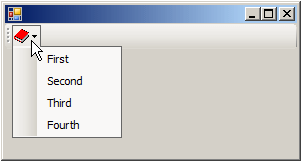
The menu items of a drop down button behave like the menu items we saw in Lessons 10-12. Based on this, you can configure the items of the button the same way we reviewed for menu items.
Separators on a Tool Bar
A separator is a vertical bar that is used to create sections or groups of items on a toolbar. There is no strict rule as to where to put a separator. Only your experience and needs will guide you.
To create a separator:
The Split Button on a Toolbar
When the user clicks a drop down button, its menu automatically displays. As an alternative, you can create a button split by a bar, showing a normal button on the left and a menu on the right. To support this, the .NET Framework provides the ToolStripSplitButton class. This class is represented by a control named Split Button. To visually add a split button to a toolbar, do one of the following:
To programmatically create a split button, declare a variable of type ToolStripSplitButton and add it to the Items property of the toolbar. Here is an example:
using System.Drawing;
using System.Windows.Forms;
public class Exercise : System.Windows.Forms.Form
{
ToolStrip toolbar;
ToolStripSplitButton btnTypesOfApplications;
public Exercise()
{
InitializeComponent();
}
void InitializeComponent()
{
toolbar = new ToolStrip();
btnTypesOfApplications = new ToolStripSplitButton();
toolbar.Items.Add(btnTypesOfApplications);
Controls.Add(toolbar);
}
[STAThread]
static int Main()
{
System.Windows.Forms.Application.Run(new Exercise());
return 0;
}
}
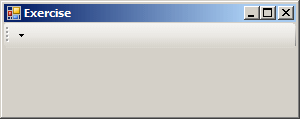
There are two ways a user can use a split button, by clicking the button itself on the left or the arrow on the right. When the arrow button is clicked, a menu displays. The menu items that display are of type ToolStripItem. This means that you create them using the same descriptions we saw for menus.
using System.Drawing;
using System.Windows.Forms;
public class Exercise : System.Windows.Forms.Form
{
ToolStrip toolbar;
ToolStripSplitButton btnTypesOfApplications;
public Exercise()
{
InitializeComponent();
}
void InitializeComponent()
{
toolbar = new ToolStrip();
btnTypesOfApplications = new ToolStripSplitButton();
btnTypesOfApplications.Image = Image.FromFile(@"C:\Exercise\apps.ico");
btnTypesOfApplications.DisplayStyle = ToolStripItemDisplayStyle.Image;
btnTypesOfApplications.DropDownItems.Add(new ToolStripMenuItem("Work Processing"));
btnTypesOfApplications.DropDownItems.Add(new ToolStripMenuItem("Spreadsheet"));
btnTypesOfApplications.DropDownItems.Add(new ToolStripMenuItem("Databases"));
btnTypesOfApplications.DropDownItems.Add(new ToolStripMenuItem("Presentation"));
toolbar.Items.Add(btnTypesOfApplications);
Controls.Add(toolbar);
}
[STAThread]
static int Main()
{
System.Windows.Forms.Application.Run(new Exercise());
return 0;
}
}
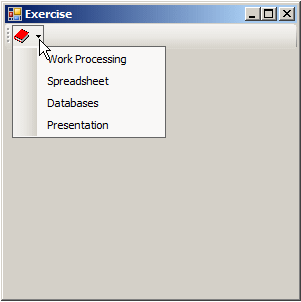
Labels on a Toolbar
You can create a section on a toolbar to display text. To support this, the .NET Framework provides the ToolStripLabel class, which is derived from the ToolStripItem class.
To visually create a label:
As its name indicates, a label is meant to display text. After adding it to a toolbar, assign a string to its Text property.
Instead of simple text, you can make a label behave like a link. To support this, the ToolStripLabel class is equipped with a Boolean property named IsLink. If you set this property to true, the label would follow the standard description of a web link (without the link itself; you must find a way to make it the desired link).
A Text Box on a Toolbar
You can add a text box to a toolbar so the user can type something in it or read text from it. To make this possible, you can use a class named ToolStripTextBox. To add a text box to a toolbar:
To programmatically add a textbox to a toolbar, declare a variable of type ToolStripTextBox. The ToolStripTextBox class is equipped with 3 constructors. The default constructor is used to create a normal and simple text box. After declaring and initializing the variable, add it to the Items property of the toolstrip. Here is an example:
using System.Drawing;
using System.Windows.Forms;
public class Exercise : System.Windows.Forms.Form
{
ToolStrip toolbar;
ToolStripTextBox txtFullName;
public Exercise()
{
InitializeComponent();
}
void InitializeComponent()
{
toolbar = new ToolStrip();
txtFullName = new ToolStripTextBox();
toolbar.Items.Add(txtFullName);
Controls.Add(toolbar);
}
[STAThread]
static int Main()
{
System.Windows.Forms.Application.Run(new Exercise());
return 0;
}
}
This would produce:
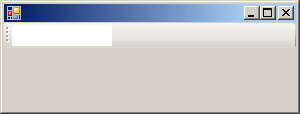
Most of the time, you create an empty text box in which a user can enter text. At any time, if you want to display text in the text box, assign a string to the Text property of the button. This can be done as follows:
void InitializeComponent()
{
toolbar = new ToolStrip();
txtFullName = new ToolStripTextBox();
txtFullName.Text = "John Doe";
toolbar.Items.Add(txtFullName);
Controls.Add(toolbar);
}
The text box of a toolbar uses the normal features of a Microsoft Windows text box.
A Combo Box on a Toolbar
You can add a combo box to a toolbar to provide a list from which the user can select an item. The combo box is handled by the ToolStripComboBox class. To visually add a combo box to a toolbar, perform one of the following actions:
To programmatically create a combo box, declare a variable of type ToolStripComboBox. The ToolStripComboBox class has 3 constructors. Use the default constructor to create a combo box. Initialize the variable and add it to the Items property of the toolbar. Here is an example:
using System.Drawing;
using System.Windows.Forms;
public class Exercise : System.Windows.Forms.Form
{
ToolStrip toolbar;
ToolStripComboBox cbxCategories;
public Exercise()
{
InitializeComponent();
}
void InitializeComponent()
{
toolbar = new ToolStrip();
cbxCategories = new ToolStripComboBox();
toolbar.Items.Add(cbxCategories);
Controls.Add(toolbar);
}
[STAThread]
static int Main()
{
System.Windows.Forms.Application.Run(new Exercise());
return 0;
}
}
This would produce:

One of the properties of the combo box of a toolbar is named ComboBox. This property is of type ComboBox. This property can be assigned a predefined object that has all the desired and necessary characteristics of a Microsoft Windows combo box.
A Progress Bar on a Tool Bar
A progress bar is used to show the evolution of something by drawing continuous rectangles, usually blue. To support them on a toolbar, the .NET Framework provides the ToolStripProgressBar class. This class inherits from the ToolStripControlHost class.
To visuall add a progress bar on a toolbar:
To programmatically create a progress bar to be hosted by a toolbar, declare a variable of type ToolStripProgressBar. The ToolStripProgressBar class has two constructors. You can use the default constructor to declare the variable, initialize it using the new operator, and add it to the Items property of a ToolStrip variable. Here is an example:
using System.Drawing;
using System.Windows.Forms;
public class Exercise : System.Windows.Forms.Form
{
ToolStrip toolbar;
ToolStripProgressBar pgrEvolution;
public Exercise()
{
InitializeComponent();
}
void InitializeComponent()
{
toolbar = new ToolStrip();
pgrEvolution = new ToolStripProgressBar();
toolbar.Items.Add(pgrEvolution);
Controls.Add(toolbar);
}
[STAThread]
static int Main()
{
System.Windows.Forms.Application.Run(new Exercise());
return 0;
}
}
This would produce:
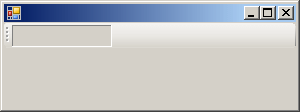
After creating a progress bar, you must find a way to make it display its rectangle (and why).
Introduction to Status Bars
Description
A status bar is a horizontal bar that displays in the bottom section of a form or application. The original purpose of the status bar was to display messages to the user. Modern status bars have seen their roles expanded. Still, the primary job of a status bar is to show some text depending on what is going on in the application. Here is an example of a status bar that shows the coordinate location of a mouse inside a drawing board of a paint program:
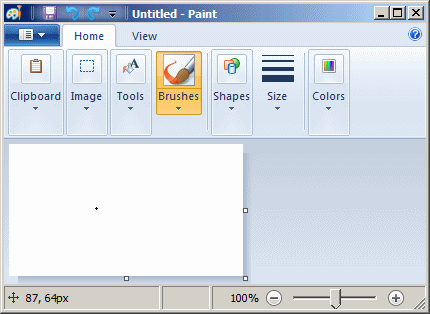
A status bar is a control container that is usually made of sections. The sections of a status bar are called panels. The roles of the panels are left to the programmer.
Creating a Status Bar
You can create a status bar visually or programmatically. To support status bars, the .NET Framework provides a class named StatusStrip. The StatusStrip class is derived from the ToolStrip class, from which it gets its primary functionality.
The previous versions of the .NET Framework, namely 1.0, included a class named StatusBar used to create a status bar. That class is still available and you can use it if you want. In our lessons, unless specified otherwise, we will use the StatusStrip class or the StatusStrip object from the Toolbox. |
To assist you with visually creating a status bar, the Toolbox provides a StatusStrip button in its Container section. You can click it and click a form. To programmatically create a status bar, declare a variable of type StatusStrip and add it to the Controls property of the form. Here is an example:
using System.Drawing;
using System.Windows.Forms;
public class Exercise : System.Windows.Forms.Form
{
StatusStrip statusbar;
public Exercise()
{
InitializeComponent();
}
void InitializeComponent()
{
statusbar = new StatusStrip();
Controls.Add(statusbar);
}
[STAThread]
static int Main()
{
System.Windows.Forms.Application.Run(new Exercise());
return 0;
}
}
This would produce:
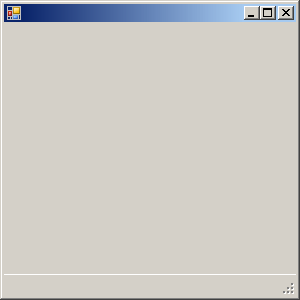
If you have a good reason to do so, you can add more than one status bar to a form.
Characteristics of a Status Bar
Introduction
A status bar can be used for its aesthetic characteristics as it can be made to display sunken or raised bars to the bottom of a form:
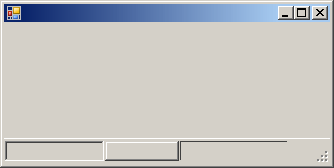
Other than that, a status bar can be made to display other items.
Like a toolbar, a status bar is an intermediary container, meaning it must be positioned on another container, which is usually a form. The default Dock value of a status bar is Bottom.
The Items on a Status Bar
To manage its panels, the StatusStrip class inherits the functionalities of its panels from the inherited Items property. As seen for the ToolStrip toolbar, to create the panels of a status bar:
This would open the Items Collection Editor. Use it to add the desired items that would then create the panels.
Like a toolbar, a status bar can host some items. A status bar is primarily used to display text. To get such text, you can create a label and add it to the status bar. A label on a status bar is an object of type ToolStripStatusLabel. The ToolStripStatusLabel class inherits from a class named ToolStripLabel.
To visually add a label to a status bar:
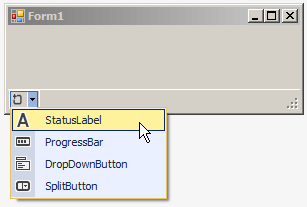
To programmatically add a label to a status bar, declare a variable of type ToolStripStatusLabel, initialize it, and add it to the Items property of the StatusStrip variable. Here is an example:
using System.Drawing;
using System.Windows.Forms;
public class Exercise : System.Windows.Forms.Form
{
StatusStrip statusbar;
ToolStripStatusLabel lblMessage;
public Exercise()
{
InitializeComponent();
}
void InitializeComponent()
{
statusbar = new StatusStrip();
lblMessage = new ToolStripStatusLabel();
statusbar.Items.Add(lblMessage);
Controls.Add(statusbar);
}
[STAThread]
static int Main()
{
System.Windows.Forms.Application.Run(new Exercise());
return 0;
}
}
Like the label of a toolbar, the label of a status bar can be made to display text, an icon, or both. This is handled by the DisplayStyle property that has the same options as the other.
The label of a status bar is highly configurable. It has the ability to sink or raise its borders. If you want to control the borders of a label, first use its BorderSides property:

You can do this programmatically as follows:
void InitializeComponent()
{
statusbar = new StatusStrip();
lblMessage = new ToolStripStatusLabel();
lblMessage.BorderSides = ToolStripStatusLabelBorderSides.All;
statusbar.Items.Add(lblMessage);
Controls.Add(statusbar);
}
After setting the BorderSides property, select the type of border you want in the BorderStyle property:
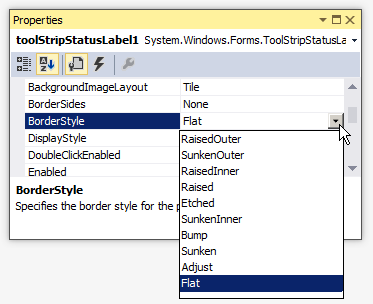
You can also specify the border style programmatically. Here is an example:
void InitializeComponent()
{
statusbar = new StatusStrip();
lblMessage = new ToolStripStatusLabel();
lblMessage.AutoSize = false;
lblMessage.Width = 125;
lblMessage.BorderSides = ToolStripStatusLabelBorderSides.All;
lblMessage.BorderStyle = Border3DStyle.Sunken;
statusbar.Items.Add(lblMessage);
Controls.Add(statusbar);
}
This would produce:
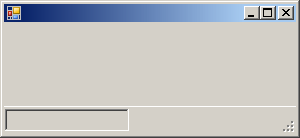
Besides the label, a status bar can also contain a drop down button, a split button, and/or a progress bar.
![]() Practical Learning: Populating a Status Bar
Practical Learning: Populating a Status Bar
|
|
|||
| Previous | Copyright © 2010-2024, FunctionX | Friday 10 June 2022 | Next |
|
|
|||